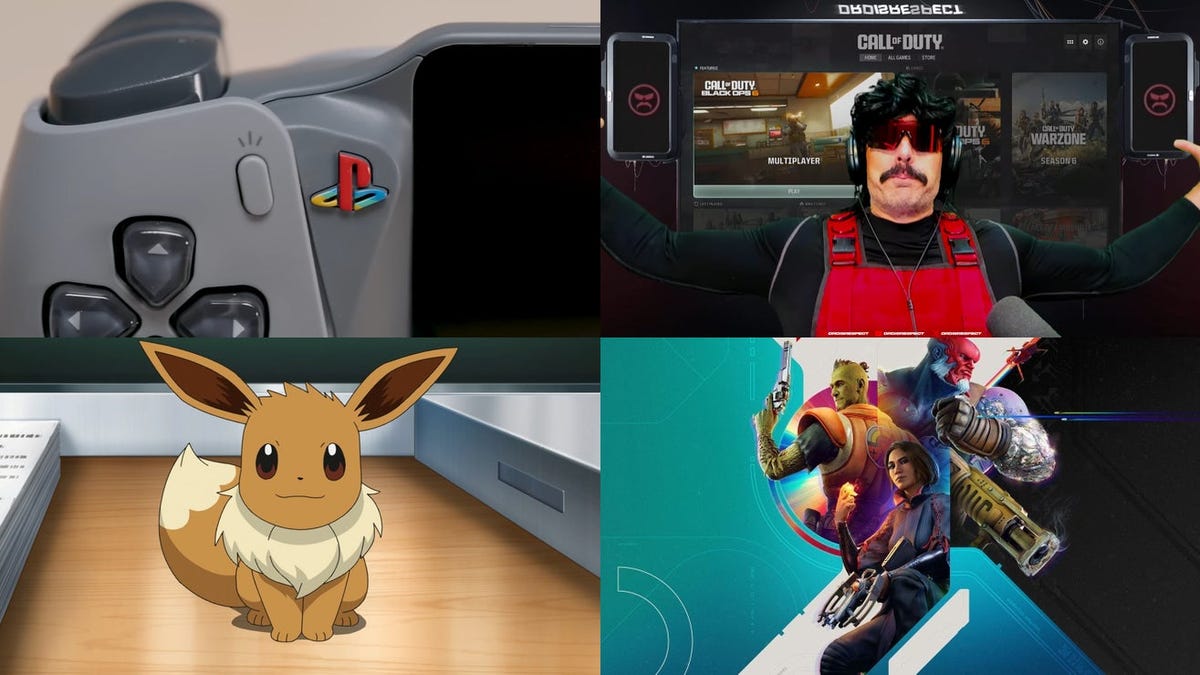
The Concord Studio Gets Shut Down And More Top Gaming Stories

This week, people desperate for Nintendo to finally pull back the curtain on the successor to the Switch instead got an announcement that the acclaimed role-playing game Xenoblade Chronicles X, previously only available on Wii U, will make its way to the handheld hybrid next year. Also, Guy “Dr Disrespect” Beahm was denied by YouTube in his efforts to have his channel’s monetization reinstated, and Sony shuttered Firewalk Studios, the team behind sci-fi shooter Concord. These stories and more await in the pages ahead.
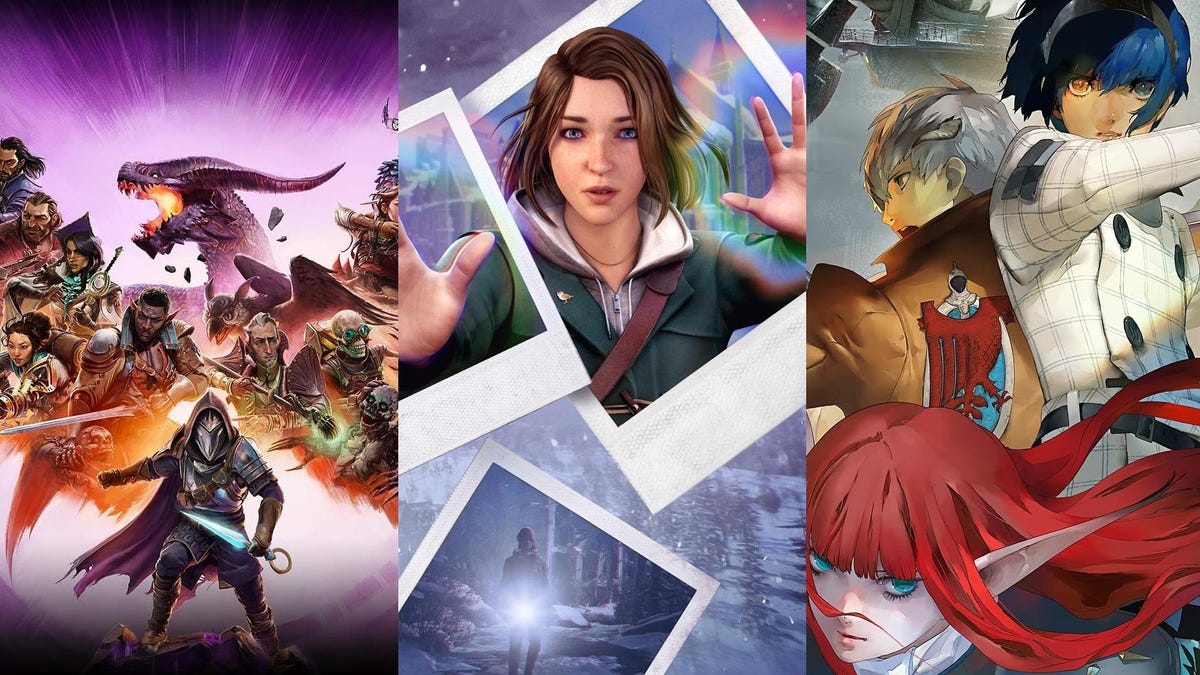
5 Great Games To Clear Off Your Backlog
Play it on: PlayStation 4, PlayStation 5, Xbox Series X/S, Xbox One, Nintendo Switch, PC
Current goal: Get some gaming spooks in for the season
This year, Halloween fell on a Thursday, and I was so busy with work and other things that I didn’t manage to make much time for spooky gaming in the days leading up to it. I still have a hankering for some interactive scares, however, so this weekend, I hope to play one of the landmark games in the history of survival horror, officially translated into English and released in the States for the first time: Clock Tower. The new version, Clock Tower: Rewind, comes to us courtesy of WayForward and represents my first real chance to play the 1995 SNES horror classic.
I actually don’t know much about the original Clock Tower, and I’ve kept it that way on purpose, as I want to go in knowing as little as possible and figure it out for myself. It’s scarier that way. But in short, it’s a 2D, survival horror point-and-click game that tells the story of Jennifer, a teenage orphan who’s adopted by a family with a big, spooky manor, and finds herself stalked by a horrifying entity known as Scissorman. WayForward’s release lets you play an enhanced version of the game “which features numerous gameplay additions and quality-of-life refinements,” and I may check that out as well, but for starters, I’ll be playing in Original mode, and experiencing the game just like it was when it scared the socks off of so many Japanese players way back in 1995. Sure, it may be November now, but I’m gonna linger in late October for just a little bit longer if it’s all the same to you. — Carolyn Petit

Chappell Roan’s SNL Look Has Dragon Age Fans Excited

We love Chappell Roan here at Kotaku. The “Good Luck, Babe” singer puts out queer bangers, dresses up in chainmail at award shows, and has cultivated a fanbase of gay nerds who record her shows on Nintendo handhelds. So when she shows up on Saturday Night Live this weekend on November 2, I will be tuned in and seated. But before the show airs, Roan has already appeared in some promotional material for the show, and her outfit has activated Dragon Age fans, as if they aren’t already having a stimulating week after the launch of The Veilguard on Halloween.
Roan is scheduled to be the musical guest for this week’s Saturday Night Live, with stand-up comedian and former SNL writer John Mulaney set to host the show. Both appeared in some promotional videos for the episode, and yeah, Mulaney is there, but Roan’s elaborate outfit is the star of the show. The green and gold outfit features a huge crescent headpiece with gold waist pieces stretching out to the side that seemingly double as armrests. The whole fit is something straight out of a fantasy RPG, and folks in fandoms like Final Fantasy are jumping on the jokes. However, Dragon Age is fresh in everyone’s minds and I, too, had to laugh at how Roan’s outfit is evocative of Ghilan’nain, one of the elven gods the player faces in The Veilguard.
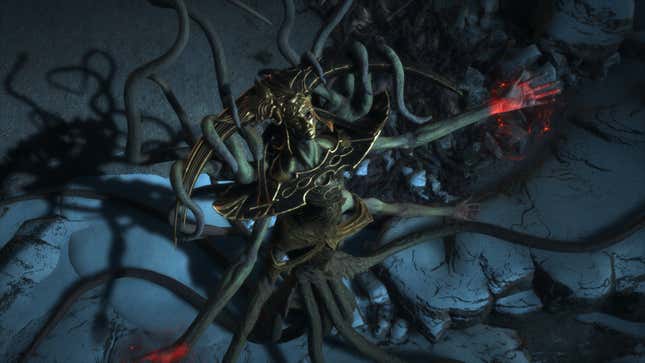
Ghilan’nain is a blighted elf, and without getting too into the weeds, that means her body has been twisted into a monstrous eldritch horror. This lady has multiple sets of arms and tentacles, and her face is hidden under a mask connected to a crescent headpiece. In close-up shots you can see her face is just as horrifying beneath the mask, and why she was so willing to become this monstrosity is part of the story you’ll uncover in The Veilguard. With the headpiece and tendril-like appendages, Roan’s outfit calls to mind the elven god of guides and navigation, so Dragon Age fans are all making the same joke.
Ghilan’nain is nothing like Chappell Roan, though. Is the elven god a queer icon? I mean, not yet, but she could be. But all I’ve ever seen her do is try to kill the queer friend group that is The Veilguard. That’s not very “ally” of her.

The Veilguard Sets Launch Day Steam Record For EA
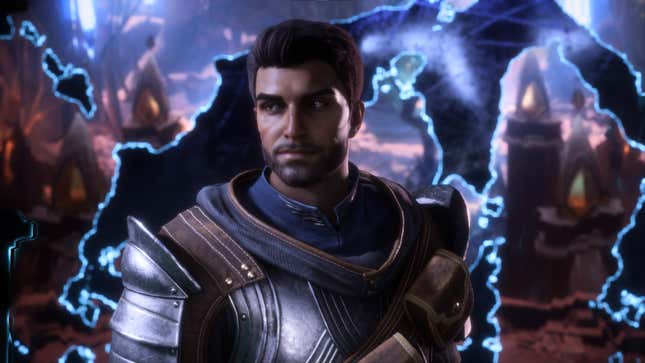
Long-time fans of the Dragon Age franchise impatiently waited for ten years between the launch of Dragon Age: Inquisition and Dragon Age: The Veilguard. Despite the lengthy downtime between entries and the drastic changes in gameplay and art style in the latest release, it appears BioWare didn’t lose its magic touch for the series. It’s been revealed that Dragon Age: The Veilguard is EA’s biggest single-player game launch on Steam to date, outshining even Star Wars Jedi: Survivor last year, which topped charts and broke player records for the publisher.
On launch day, Dragon Age: The Veilguard enjoyed an all-time peak player count of just over 70,000, which is truly impressive for a single-player game. The day after launch—a work day for most people—saw those numbers sitting around 62,000. Now, I know many people will think 70,000 isn’t all that impressive, as it doesn’t break the top ten most-played games on Steam, but it did surpass Baldur’s Gate 3 for a time, which is no small feat. Even more impressive is that, on day one, Dragon Age: The Veilguard outsold Call of Duty: Black Ops 6 on Steam, pushing the FPS down a spot on the top seller’s leaderboard.
If you spend any amount of time online today, you’ll find plenty of discourse surrounding Dragon Age: The Veilguard. A vocal minority continues downplaying its significance, claiming the Monster Hunter Wilds beta test outperforms the full Dragon Age release. Yeah, it does. But Monster Hunter Wilds is a free-to-play, limited beta. So, obviously it’ll outperform a full-price RPG. We can celebrate both!
So, why is Dragon Age: The Veilguard outperforming EA’s other single-player hits? It’s a well-crafted RPG with action-combat mechanics, impressive world design, perhaps one of the best character creators in the genre, and an expansive storyline spanning nearly 100 hours to complete. Oh, and it’s Steam Deck compatible and doesn’t require the EA App!
If you’re jumping into Dragon Age: The Veilguard this weekend, pay close attention if you want to unlock the game’s secret ending!
.
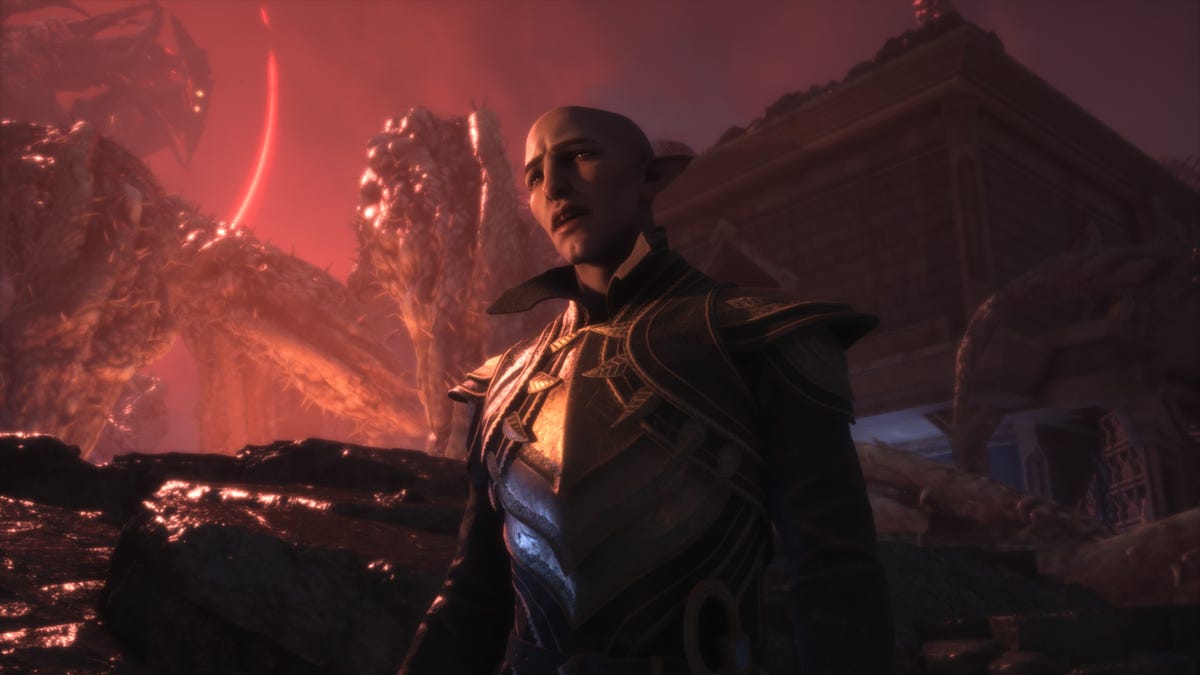
The Veilguard’s Most Important Quest Is Missable

Dragon Age: The Veilguard has a ton of side quests throughout its multiple hub worlds, but one stands apart as probably the most important in the game, if not the entirety of BioWare’s fantasy RPG series. If you’re concerned about spoilers, don’t worry, we won’t get into them here. This is just a PSA to everyone playing the game that if you want to see some of the most important story and character work in The Veilguard, you should seek out Solas’ memories in The Crossroads.
These questlines are twofold: First, you’ll find short quests that depict playable flashbacks to the original elven rebellion led by Solas eons before the events of The Veilguard, then you’ll have a debrief about them with your team. Solas, the Inquisition party member who turned out to be the elven god of lies, has existed throughout large swaths of Dragon Age history, and to learn about his history is to understand the past of the fantasy world of Thedas. Each of these quests will end with you collecting a wolf statue to bring back to your home base. Once there, you can view an artistic depiction of one of Solas’ regrets from his time among the elven pantheon. These include some of the biggest lore drops BioWare has ever put in a Dragon Age game, and fundamentally change our understanding of this world.
You can find these memories early on, but there’s a point in the main story quests when a character will give you one of the wolf statues that puts the questline in your journal, complete with waypoints to guide you to where you need to go. Some will require you to fight mini-bosses in and out of The Crossroads, but they are worth the effort. Not only do they provide some of the best story reveals in all of The Veilguard, they’re also required to unlock the game’s secret ending, among other changes to the endgame worth seeking out.
For more on The Veilguard, check out Kotaku’s review.

Pokémon TCG Pocket Already Feels Like A Well-Laid Trap
I’m really averse to trading card games. Despite loving me some Pokémon and Yu-Gi-Oh as a kid and tween, I’ve largely kept my distance from them in the time since. I’ve played a few hands of Hearthstone, I never touched Artifact, and I am straight-up dogshit at any card game baked into an RPG, except for Queen’s Blood in Final Fantasy VII Rebirth. Maybe it’s all the stories I’ve seen of players spending exorbitant amounts of money to pull rare cards from booster packs, but the pastime seems dominated by greed and status more than the fun of the tactics and interplay between cards that I always valued.
It’s for reasons like these that I didn’t start playing Magic: The Gathering until a few weeks ago. I was going on vacation and knew I’d be around folks who play the game, so I relented and tried it. Unsurprisingly, I found that Magic is deeply fun and rewarding, but when I texted my roommate who plays the game, he warned me of the cost of it all. As did my best friends when I shared that I’d successfully been Magic-pilled. Of course, that did little to stop us from heading to a shop hosting a ludicrous sale on singles, purchasing about $45 worth of cards I simply thought looked cool, and playing another few games before I left town. My first go was a bit rough around the edges, but by the second game, I’d already been able to take out another player in a fashion that even impressed me!
With that experience in mind, as well as a single (and might I mention, triumphant) game of the Pokémon TCG under my belt, I took the plunge into Pokémon TCG Pocket, the mobile and gacha-infused adaptation of the popular card game that has ravaged my friends and their wallets the last few years. Unfortunately, it’s good, bite-sized fun, and it feels like a trap.
The slow tutorial of Pocket does a great job of introducing the fundamentals: play and evolve Pokémon, attach energies to use devastating attacks, and use items and other support cards to pull cards from your deck and keep your critters standing. There’s more to know, like retreating, benched Pokémon, abilities, and so on, but Pocket is actually a wonderful place to start if you’re looking to get into the actual card game. It plies you with prebuilt decks and solo challenges that’ll familiarize you with the ebb and flow of battle in increasingly difficult increments, eventually letting you challenge other players. Bouts in these modes are pretty generously timed, making them perfect for beginners who are dipping their toes in for the first time, and the winner is the first to three KOs, which happens quicker than you might expect. It’s no Marvel Snap, but fights in Pocket aren’t exactly drawn out like they can be in the anime or video games.
However, all of this is secondary to Pocket’s real allure and danger. Its home screen consists of a bunch of icons, buttons, and panels, but the three biggest ones in the center of the screen are booster packs, a feature called Wonder Pick, and a shop. Let’s work our way down.
First up, the booster packs: there are currently three available, all within a larger promo called Genetic Apex, and they’re centered on Pikachu, Charizard, and Mewtwo. (You can pick between the three packs at any time and it’s free to open one.) Clicking on the panel brings you to a screen where you can preview the offerings inside each pack, and cracking them is how you first gain literally any XP in the game. Before you do anything, even battling, you must open a booster pack and become familiar with Pocket’s many currencies and systems.
For example, slicing open a pack, which comes complete with a satisfying sound and vibration from your phone, generates pack points, which can then be spent on picking out single cards that range in value depending on their artwork, whether they’re holographic or not, and more. The most prominent of these currencies, though, are Pocket’s hourglasses.
Underneath both the booster packs and Wonder Pick icons are timers. The one under the former is counting down to the next time you are allowed to crack a pack—you can snag two each day, or one every 12 hours basically— and the latter’s timer is counting down to the next charge of a Wonder Pick, which can hold five charges max. The Wonder Pick allows you to spend charges to select a randomized card from booster packs that random players or your friends have recently opened. (Don’t worry, they won’t lose the card.) Say someone gets a uniquely good haul. You can then spend an appropriate amount of Wonder Pick charges—which will scale with the value of the cards included—to kind of get a chance at at least one high-value pick!
At the moment, I have two Wonder Pick charges, with a third being restored within the next eight hours. That limits the packs that I can freely pick from, meaning I can do a trio of poorly rated drops, try my hand at a slightly better one costing two charges, or wait and see if I can pull one for three. Of course, these agonizingly long waits can be reduced by simply using hourglasses, which cut down timers by an hour per unit, and the game is sure to remind you of what you’re missing out on by featuring the extravagant pulls of everyone you know on the Wonder Pick page.
The early leveling experience and tutorial also make you flush with hourglasses, to the point where I was in the hundreds within about an hour of playing. It wants you to spend those hourglasses so badly to speed up the booster pack timing, reward you with some paltry offerings and a lone full art or EX card, and then hook you on that high. There’s also already an offer in the game to upgrade to a premium pass that allows you to open a third pack a day for two weeks with no charge and access premium missions with more rewards, like card sleeves, playmats, coins, and as of this moment, even an exclusive full-art Pikachu card. The obvious hope is that you’ll forget to cancel and lapse into becoming a full-blown sub, or worse, willingly offer it because you’re that hooked.
None of these systems explicitly get in the way of you just hopping into solo or online battles, but already, I’ve run into scenarios where I’ve just narrowly eked out victories over players who’ve obviously spent the dough (or just gotten lucky enough) to pull EX Mewtwos and the like. Meanwhile, I’m using fairly rudimentary decks and building my Pokedex and binder very slowly by comparison. While surveying the cards that friends of mine had pulled, I actually felt a pang of jealousy so great that I used hundreds of hourglasses to splurge on ten booster packs, which yielded me a lot of cards, but ultimately a whole bunch of nothing.
Pocket, just like the base TCG and every gacha and service game in the world, is banking on its systems to create these kinds of frustrations—these pockets of FOMO, if you will—and push you to spend so you keep enjoying the game. And since this is Pokémon we’re talking about here, y’know, the biggest media property in the world, there’s no telling the damage it’ll ultimately wreak.
I’m also wary of investing too much into Pocket because, frankly, I’ve little trust in digital media anymore. Years of shows being cut from streaming services, as well as games getting delisted and pulled from players’ libraries, have been a stark reminder that these companies are more than happy to sell you empty promises. A physical card can at least be tucked into a sleeve or binder that you can safely put away and bring back out. The Criterion Collection movies I’ve been assembling in my entertainment center aren’t going anywhere unless I want them to. Those physical things, be they cards or movies, are things that will last with care, care that I and many others willingly give them.
So long as Pocket makes Nintendo and The Pokémon Company richer, it’ll be around. The moment it stops benefiting them materially, though, I’m sure they’ll have no problem taking it all away from us, and that awareness is inevitably going to color my experience with it.
Which is a shame, because I really am enjoying Pocket. It felt good getting to trounce that player with the Mewtwo by simply outsmarting and outplaying them. The TCG version of Pokémon will be mostly familiar to someone who’s played the games before, but there’s just enough of a tactical twist in the management of energies and the whole party to promote smart plays over raw power sometimes. It’s still very early days for Pocket, meaning it’s impossible to divine its staying power or whether all of the problems I’m flagging will remain as such. For as much joy as it might bring, just never forget to treat Pocket, as well as its developers and publishers, with the caution they deserve.
.

How To Unlock The Secret Ending
Dragon Age: The Veilguard wraps up a lot of ongoing storylines for fans of BioWare’s fantasy RPG series. But it also has some new threads to pull on, one of which is the focus of the game’s secret post-credits stinger. Unlocking this final revelation is a hefty affair that will span several quest lines. If you want to see everything The Veilguard has to offer, here’s a spoiler-free guide on how to unlock the secret post-credit scene. We’ll go over the requirements first, then we’ll throw up a spoiler warning and talk about what it all means.
How to unlock Dragon Age: The Veilguard’s post-credits ending
One of the lengthy quest lines you’ll have to complete to see The Veilguard’s post-credit scene is tracking down the wolf statues in the Crossroads. These figures unlock some massive lore bombs and backstory about Solas, the elven god at the center of The Veilguard. You’ll find these behind locked areas in the Crossroads, which will often require you to fight a mini-boss or solve a complicated puzzle. Once you’ve found all five, you’ll have a visitor in the Crossroads who will direct you to the final stage of the quest line, which can unlock another choice in the game’s finale. However, that’s not all that’s required to unlock the secret ending.
You’ll also need to find three “Mysterious Circles” hidden around Thedas. These are artifacts that are tucked away in dangerous places that are only accessible after you put in some work. One is in Arlathan Forest and requires you to complete an elaborate laser puzzle that builds a bridge to some ruins surrounded by a lake you can’t swim through.
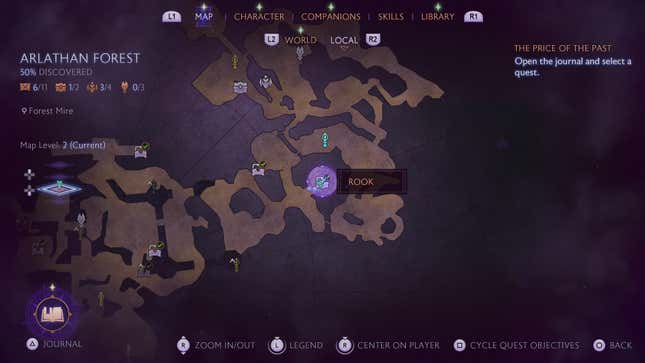
The other two are hidden behind dragon boss fights. One is in the Necropolis where you recruited Emmrich. The region is home to “The Formless One,” which is a dragon you’ll fight by completing the quests “Restless Spirits” and “Pinnacle of its Kind.” You’ll find one of the Mysterious Circles in the southwest corner of its lair.
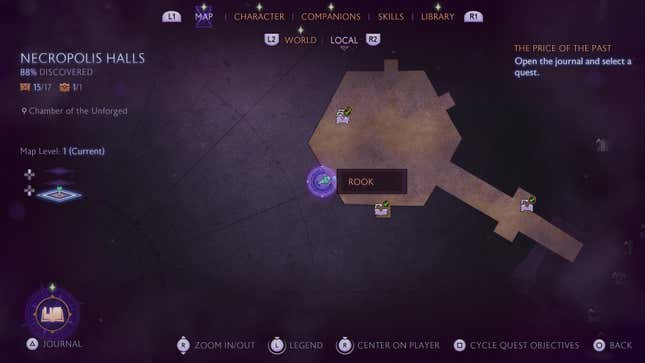
The last is perhaps the most involved of the three. This one you’ll find in the lair of a dragon in the Crossroads as part of the quest “The Heart of Corruption.” This requires you to fight three high-level champion mini-bosses throughout the Crossroads who are siphoning power from tears in the Fade. Each champion defeated gives you a key to unlock the dragon’s lair. Once you defeat the beast (a task made easier once you’ve found all five of the wolf statues), you can find the Mysterious Circle stashed away in a hidden passage south of the dragon’s arena.
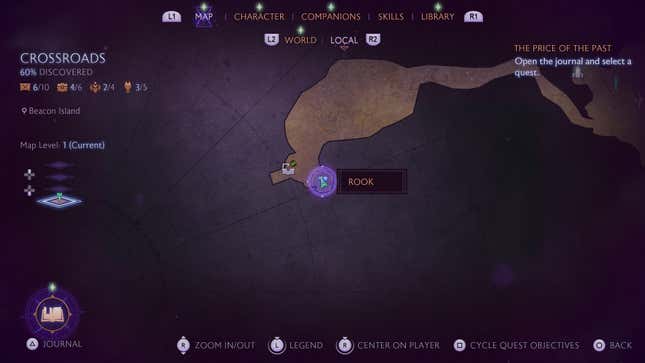
Then, all you’ve gotta do is reach the end. We won’t dive into The Veilguard’s finale here, but we will dissect the short post-credits scene below. So if you don’t want to know what it entails, skedaddle.

Are they gone?
Okay.
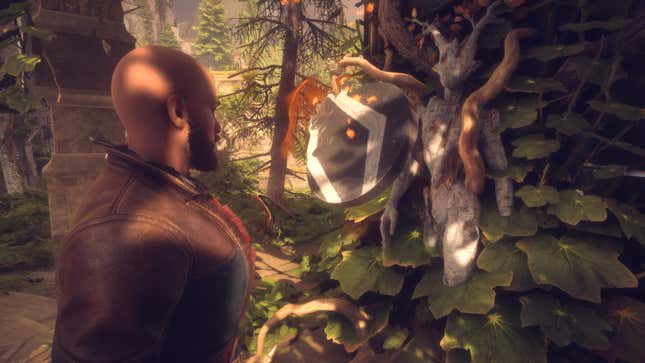
Dragon Age: The Veilguard’s secret post-credits scene, explained
The brief, one-minute clip you did all that work to unlock has a lot of wide-reaching ramifications for the Dragon Age series. It depicts art of several key events of each game in BioWare’s series, but with cloaked, shadowy figures inserted into them. This includes the Battle of Ostagar in Dragon Age: Origins that led to the loss of most of Ferelden’s Grey Wardens, Bartrand’s stealing of the Lyrium Idol in Dragon Age II and setting off a chain of events that resulted in the Mage-Templar War, and Corypheus’ opening of The Breach in Dragon Age: Inquisition and nearly destroying the world as we know it. The voiceover from a devilish, unknown individual recounts how their group has “balanced” and “guided” the people of Thedas in one way or another, resulting in the events of previous games. To what end? That’s unclear at the moment. But what is clear is that this voice and these shadowy figures are part of the Executors, an enigmatic group that was first hinted at in Dragon Age: Inquisition, then further expanded upon in the anthology book Tevinter Nights.
In Inquisition, you set up several bases throughout the world of Thedas, and eventually, you’ll receive a war table operation that tells you symbols drawn in chalk have started appearing on those bases depicting a downward-pointing triangle covered by two wavy lines. This symbol is shown at the very end of The Veilguard’s post-credits scene as the voiceover says, “We come.” This entire scene seems to imply the Executors have been putting their plans into motion by manipulating characters like Loghain and Bartrand throughout Dragon Age. Whatever they’ve been working toward is finally coming to fruition, and they are coming to Thedas in the near future.
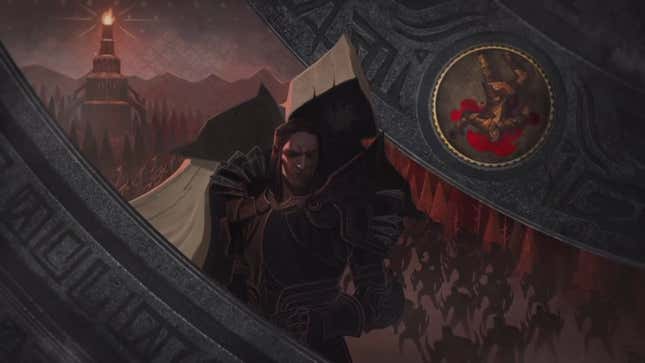
The art we see of Executors in this scene matches the descriptions in Tevinter Nights, which says they are hooded, robed figures. But we also know them to be from “across the sea,” meaning they come from a land beyond Thedas and represent some force we’ve not encountered yet in the Dragon Age series. The codex entries that you receive from the Mysterious Circles imply they could be followers of the Forgotten Ones, the disgraced elven gods who have been mostly erased from history. Given that one of the only known Executor characters was shown opposing Solas in Tevinter Nights, this seems like a possible explanation that could be further explored in a future game, given that The Veilguard takes most of the elven gods we knew of off the board.
Even outside of this secret ending, there are references to some dangerous force from across the sea in The Veilguard, such as when Taash is given a warning about them in their personal quest. Will current hero Rook be the one to fight these forces when they come knocking, or will the next Dragon Age game keep the series’ long-running tradition of bringing in a new protagonist? The Veilguard does end with a Marvel-style “The Veilguard remains vigilant” text right after this revelation which, to me, reads like a subtle implication that Rook might be leading the fight. But hey, Inquisition ended with a much more direct scene that The Inquisitor could face Solas in this game, and that didn’t happen. So we’ll have to wait and see.